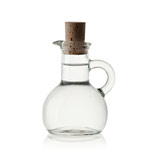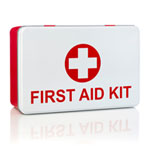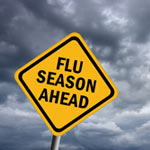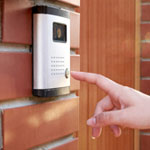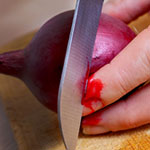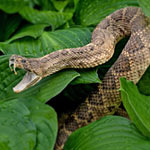Surviving a Snake Bite

Surviving a Snake Bite
“Throughout the spring and summer months, the numbers (of snakebite-related ER visits) double, triple, maybe even more than that,”1 says Diane Calello, MD, an associate professor of emergency medicine at Rutgers New Jersey Medical School in Newark.
Snake season is in full effect when the weather starts warming up. Snakes will start crawling from their winter hideouts to seek food and may come across humans along the way.
The Department of Wildlife Ecology and Conservation states there are about 7,000 to 8,000 snake bites per year and only about five or six fatalities from a snake bite per year. Even though the numbers seem slim, encounters with snakes could end up with you in the emergency room if proper precautions aren’t taken.
Snake Basics
When it comes to venomous snakes in the United States, there are two categories: pit vipers and coral snakes.

Pit Viper Snakes
Rattlesnakes, copperheads, and cottonmouths are all considered pit viper snakes. All three snakes share common physical traits like triangular heads and vertical nostrils. Of these snakes, rattlesnake venom is the most dangerous and can cause the most problems. Cottonmouth snakebites are venomous as well, but do not cause as much damage as a rattlesnake.
Coral Snakes
Mostly found in Florida and Georgia, coral snakes are black and red with either white or yellow bands.
Snake Venom
Even though pit viper bites are more common than coral snake bites, both bites are not always poisonous. This is because snakes can control when and how much venom to release with their bites. In the image below, you can see the gland where snakes hold their venom and the muscles they use to release the venom.
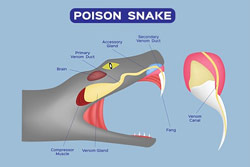
The bite depends on how great the snakes determine the threat is. Dr. Bret Nicks, a professor of emergency medicine at Wake Forest Baptist Health in Salem, North Carolina explains, “Venom causes pain and swelling and perhaps some blistering at the site of the bite, and it damages tissue.”1
Pit Viper Bite Damage
Venom from a pit viper snake can be the most destructive because it contains different compounds that destroy tissue and deteriorate the proteins that allow your blood to clot. The combined tissue damage and bleeding contributes to swelling, which can occur within the hour of being bitten.

Coral Snake Bite Damage
A snake bite from coral snakes can take 12 to 18 hours before any symptoms show. Their venom contains neurotoxins which affects the brain’s ability to control the body’s muscles. As scary as it may sound, no one has reported a fatality due to a coral snake bite since the 1960s.1
Symptoms of a Snake Bite
As stated before, some snake bites can take up to 18 hours before showing signs. In any case, you should immediately alert an emergency response team so they can better assess how to treat the bite. In the event you’re bitten, monitor any symptoms such as:
- Swelling
- Numbness
- Vomiting
- Dizziness
- Fainting
- Shock
- Rapid heartbeat
- Low blood pressure
- Skin discoloration
- Slurred speech
- Difficulty swallowing
- Weak muscles
- Blurred vision
- Paralysis
- Difficulty breathing
- Tingling
- Diarrhea
- Thirst
Do’s and Don’ts of a Snake Bite
If you’re bitten by a snake, you should try to take these actions if at all possible:
- Remain calm and move away from the snake.
- Seek medical attention immediately.
- Remove jewelry or tight clothing to prepare for the swelling.
- Clean the wound, but don't flush it with water. Cover it with a clean, dry dressing.
- Keep the limb still, unless you have to walk.
- Keep the limb at heart level, in a splint.
- Wait to see how you feel before you seek medical attention
- Take a risk or waste time trying to capture or kill the snake
- Apply ice or heat to the bite
- Cut the wound
- Suck on the wound with your mouth
- Use a suction device on the wound
- Shock the wound with electricity
- Drink alcohol, drink caffeine, eat, or take medications
Prevention
Being aware of where snakes typically are, how to move around them, and how to not provoke them are the best ways to prevent a bite. When you’re in a situation that may involve snakes, try these tips:
- Pay attention to where you walk. A snake likely won’t bite unless you step on it.
- Avoid alcohol in order to remain alert.
- Carry a walking stick to tap the ground in front of you. If a snake feels threatened, it will be more likely to attack the stick.
- Wear boots and long pants to protect your ankles.
- Wear a headlamp or carry a flashlight at night so you can see snakes before you have a surprise encounter.
Fortunately, snakes in the United States are typically not aggressive and only bite when they feel threatened. The best way to avoid a snake bite is to be aware of where to look for snakes, take appropriate precautions to dodge them, and never approach them. In the event you’re bitten, take the proper actions and prepare to spend up to 24 hours in the hospital.
This advice is not from a trained medical professional.
1. WebMD, How to Survive Snake Season, Even if You Get Bitten, 2018
You might also be interested in...
-
 10 Signs You May Not Be Drinking Enough Water
10 Signs You May Not Be Drinking Enough Water
-
 8 Signs You May Not Be Getting Enough Magnesium
8 Signs You May Not Be Getting Enough Magnesium
-
 About Life Insurance
About Life Insurance
-
 Do You Really Need Life Insurance?
Do You Really Need Life Insurance?
-
 Does Divorce Spell The End Of A Happy Childhood
Does Divorce Spell The End Of A Happy Childhood
-
 Globe Life is Rated A (Excellent)
Globe Life is Rated A (Excellent)
-
 Health Symptoms You Should Never Ignore
Health Symptoms You Should Never Ignore
-
 History of Life Insurance
History of Life Insurance
-
 Home Cough Remedies
Home Cough Remedies
-
 How High Should Your SPF Be
How High Should Your SPF Be
-
 How To Be Responsible About Life Insurance
How To Be Responsible About Life Insurance
-
 Is Eating Organic Really Safer?
Is Eating Organic Really Safer?
-
 Is White Vinegar A Safe Cleaning Agent?
Is White Vinegar A Safe Cleaning Agent?
-
 Planning Your Family For An Emergency Evacuation
Planning Your Family For An Emergency Evacuation
-
 The Difference Between Power Of Attorney And A Living Will
The Difference Between Power Of Attorney And A Living Will
-
 Reconsider Getting a Life Insurance Policy
Reconsider Getting a Life Insurance Policy
-
 Setting Goals For Your Employees
Setting Goals For Your Employees
-
 Skills that Make Bosses Want to Hire You
Skills that Make Bosses Want to Hire You
-
 The Importance of Life Insurance
The Importance of Life Insurance
-
 The Importance of Term Life Insurance
The Importance of Term Life Insurance
-
 Is It Time To Review Your Life Insurance Policy?
Is It Time To Review Your Life Insurance Policy?
-
 Tips On How To Prevent E.coli
Tips On How To Prevent E.coli
-
 Too Busy to Stay Healthy?
Too Busy to Stay Healthy?
-
 What Is COPD And How You Can Prevent It?
What Is COPD And How You Can Prevent It?
-
 What is Term Life Insurance?
What is Term Life Insurance?
-
 When Insurance Becomes an Investment
When Insurance Becomes an Investment
-
 Choosing Whole Life Vs Term Life Insurance
Choosing Whole Life Vs Term Life Insurance
-
 Why You Should Look Into Term Life Insurance
Why You Should Look Into Term Life Insurance
-
 Making Your Home Senior-Friendly
Making Your Home Senior-Friendly
-
 Is Whooping Cough Making A Comeback
Is Whooping Cough Making A Comeback
-
 Unusual Tricks To Reduce The Risk Of Heart Disease
Unusual Tricks To Reduce The Risk Of Heart Disease
-
 The Best First Aid Kit Everyone Should Have
The Best First Aid Kit Everyone Should Have
-
 Beware Of Dangerous Mold
Beware Of Dangerous Mold
-
 5 Things You Should Know About Thyroid Health
5 Things You Should Know About Thyroid Health
-
 What Your Eyes Reveal About Your Health
What Your Eyes Reveal About Your Health
-
 Everyday Things That Can Cause Memory Loss
Everyday Things That Can Cause Memory Loss
-
 How To Discuss Life Insurance With Your Spouse
How To Discuss Life Insurance With Your Spouse
-
 Why That Cold Won’t Go Away
Why That Cold Won’t Go Away
-
 5 Ways To Keep A Healthy Smile
5 Ways To Keep A Healthy Smile
-
 How Dangerous Is Sugar?
How Dangerous Is Sugar?
-
 5 Warning Signs To Change Healthcare Providers
5 Warning Signs To Change Healthcare Providers
-
 Simple Secrets To Conquer Flu Season
Simple Secrets To Conquer Flu Season
-
 The Hidden Bad Side Of Everyday Foods
The Hidden Bad Side Of Everyday Foods
-
 How To Avoid The Scams That Tricked So Many
How To Avoid The Scams That Tricked So Many
-
 Six Foods That May Reduce Stroke Risk
Six Foods That May Reduce Stroke Risk
-
 Empty Nesters: Don’t Ditch Life Insurance Until You Consider This
Empty Nesters: Don’t Ditch Life Insurance Until You Consider This
-
 How Does Accidental Death Insurance Work?
How Does Accidental Death Insurance Work?
-
 4 Tips To Improve Your Credit Score
4 Tips To Improve Your Credit Score
-
 6 Tech Devices You Need For Family Safety
6 Tech Devices You Need For Family Safety
-
 Public Transportation Safety Tips
Public Transportation Safety Tips
-
 Is Globe Life Insurance Reliable?
Is Globe Life Insurance Reliable?
-
 Hazards in the Kitchen: What You Do Every Day that Puts You at Risk for a Serious Accident
Hazards in the Kitchen: What You Do Every Day that Puts You at Risk for a Serious Accident
-
 Surviving a Snake Bite
Surviving a Snake Bite
-
 Is Globe Life Insurance Term or Whole Life?
Is Globe Life Insurance Term or Whole Life?
-
 The Top 4 Leading Causes of Death for People Older Than 50 and How to Avoid Them
The Top 4 Leading Causes of Death for People Older Than 50 and How to Avoid Them
-
 Nine Eye-Opening Stats That Will Make You Rethink Texting and Driving
Nine Eye-Opening Stats That Will Make You Rethink Texting and Driving
-
 Risks of Dying from Cancer
Risks of Dying from Cancer
-
 What are the Odds of Dying While Taking a Selfie?
What are the Odds of Dying While Taking a Selfie?
-
 Can I Get an Accidental Death Quote Online?
Can I Get an Accidental Death Quote Online?
-
 Buying Life Insurance for the Whole Family
Buying Life Insurance for the Whole Family
-
 What You Need to Know Before Buying Term Life Insurance
What You Need to Know Before Buying Term Life Insurance
-
 Advantages and Disadvantages of Getting Life Insurance without a Medical Exam
Advantages and Disadvantages of Getting Life Insurance without a Medical Exam
-
 A New Year's Resolution You Can Keep: Buy Life Insurance
A New Year's Resolution You Can Keep: Buy Life Insurance
-
 Food Contamination: Ways to Avoid the Potential Dangers and Keep Food Safe
Food Contamination: Ways to Avoid the Potential Dangers and Keep Food Safe
-
 Can I Increase the Face Value of My Term Life Insurance?
Can I Increase the Face Value of My Term Life Insurance?
-
 What is Mortgage Protection Insurance?
What is Mortgage Protection Insurance?
-
 Do I need Accidental Death Insurance?
Do I need Accidental Death Insurance?
-
 How Does a Graded Death Benefit Whole Life Insurance Policy Work?
How Does a Graded Death Benefit Whole Life Insurance Policy Work?

 Insurance products are available in New York from
Insurance products are available in New York from  Insurance products are available in your state from
Insurance products are available in your state from 

















